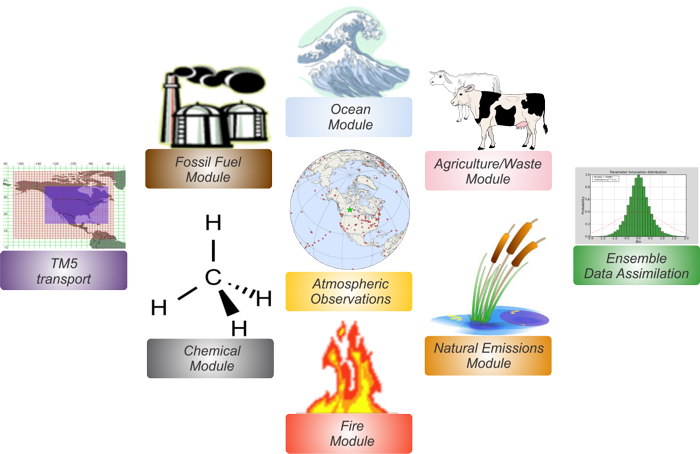Information
Home FAQ Project Goals Documentation Collaborators TutorialResults
Fluxes Observations Evaluation Visualization DownloadGet Involved
Suggestions E-mail List Contact UsResources
How to Cite Version History Glossary References Bibliography
To learn more about a CarbonTracker component, click on one of the above images.
Or download the full PDF version for convenience.
Fossil Fuels
Introduction
Humans first began influencing the carbon cycle by adapting their environment to fit their needs (landuse change). Early humans used fire to control animals and later cleared forest for agriculture. Over the last two centuries, following the industrial and technical revolutions as well as significant increase in global population, fossil fuel combustion is now the largest anthropogenic source of CO2. Coal, oil and natural gas are the most common energy sources in both developed and developing countries. Methane is the principle component of natural gas. Methane leaks to the atmosphere durring natural gas production and transport and these leaks contribute a considerable amount to the overall atmospheric methane levels. Additionally, natural gas can be a side product of oil production and is often flared, or vented to the atmosphere. Together, anthropogenic emissions from oil and gas production are thought to contribute about 50 TgCH4/yr (~10% of the global annual methane sources). Methane is also associated with coal deposits and can be released when pulverizing coal. Power plants capture these emissions and often vent them directly to the atmosphere from coal mines, which contribute an additional ~20 TgCH4/yr.
Coal is a relatively inexpensive source for power. In the U.S., coal has the added advantage of being produced domestically and as a result, provides roughly half of our energy needs. Unfortunately, coal has high environmental costs. Leveling of mountains, pollution of waterways, emissions of sulfur and nitrogen oxides, as well as mercury are all associated with coal production and combustion. In addition, the amount of CO2 emitted per unit of energy produced is about twice that for natural gas, making coal an environmentally costly choice for energy production. As Asian economies have grown, coal production has increased in these countries by a factor of about two since 2000, while it has remained stable for much of the rest of the world. In 2010, Chinese production of coal increased by 9% from the previous year (BP Statistical Energy Review, 2011).
Combustion of natural gas is currently used to generate about one quarter of the electricity produced in the U.S.. Its popularity as a fuel has recently grown due to its efficiency and because it is relatively clean. Recent technological advances in the recovery of natural gas, principally hydraulic fracturing, have led to increases in reserve estimates. It is now thought that the U.S. has a large enough natural gas supply to last nearly a century based on current consumption. The impact of hydraulic fracturing on greenhouse gas emissions is currently a topic of intense research. One study suggests that methane emissions from hydraulic fracturing may be 30% higher than emissions from conventional wells (Howarth et al., 2011). In any case, it is likely that as natural gas reserves are increasingly exploited, emissions related to its production will also rise.
Detailed Description
This release of CarbonTracker-CH4 uses a 1x1 degree gridded emission levels from the EDGAR 3.2FT2000 for fugitive emissions from coal, oil and gas production. This data set is based on emission inventories by country and sector for the years 1990 and 1995 and is extended for the year 2000 by using production and consumption statistics. We have not extrapolated this data over the period covered by CarbonTracker, and have instead kept prior emission estimates constant at 2000 levels. This allow us to test whether the assimilation is able to recover, for example, the large increase in emissions from coal production in Asia. It turns out that this is a very stringent test of the assimilation system because few observation sites are likely to be located near fossil fuel production locations, making it very difficult to detect emission changes.
